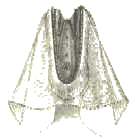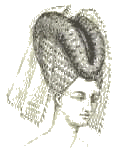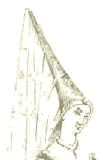|
|
|
The hat has always existed in any number of shapes and in various materials. Then, cumulating the roles, it revealed itself very efficient as a straw broad-brimmed hat to protect oneself from the sun and as a wool-coned hood that keeps out the cold.
If to cover constituted one of the functions of the hat, to hide, when hair was lacking, was another function. Just like to attract attention to oneself. Thus, perched on the pretty heads of those ladies of the court, the hat reached summits. So, the hennin, pointed hood, brought to fashion by Isabeau of Bavaria, was no less than eighty centimetres high.
 |
 |
 |
 |
 |
| Hennins of 15th century | ||||
The hat also had its extravagant period and gave the ladies the occasion to demonstrate their desire for originality, fantasy and elegance. During two centuries, it gained the respect of social codes, the desire to be the most beautiful and the need to be different from other.
By the hat, one recognized the social rank (the aristocratic high-hat, the worker's cap), the profession (the cook's cap, the mailman's cap, the nurse head-dress, the kepi), the religion (the tchador, the kippa), the geographic origins (the french beret, the mexican sombrero), the important events (marriages, funerals).
Welcome | Catalogue | A job under the skin | Tools | Once upon a time | e-mail